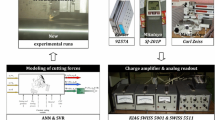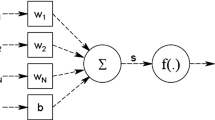Abstract
High-speed oblique cutting temperature is an important factor in ensuring workpiece quality. In order to gain the temperature real time in the cutting process, a prediction method based on least squares support vector machine (LS-SVM) was proposed. To verify the feasibility of the method, firstly, the high-speed cutting temperature model was established based on LS-SVM, and the major operation parameters (cutting speed, feed rate, axial depth of cut, and radial width of cut) were chosen as the model input based on oblique cutting process analysis; secondly, the cutting experimental scheme was designed applying the Box–Behnken experimental design method for gaining more cutting temperature data and less experimental times. Then, a high-speed cutting temperature measurement system was established based on a MCV850 vertical machining center for testing the reliability of model prediction. Finally, the model prediction results based on LS-SVM and neural networks were compared. And the results show the prediction error of the model gained is less than 1 %, and taking two-group random parameters as test data with different with Box–Behnken experimental parameters designed before, the percentages of prediction data deviation measurement were 0.83 and 0.51 %, respectively. The results demonstrate the feasibility of applying the cutting temperature prediction model in predicting the main required processing parameters.
Similar content being viewed by others
References
Li B, Zhu D, Pang J (2011) Quadratic curve heat flux distribution model in the grinding zone. Int J Adv Manuf Technol 54:931–940
Jianfeng Z, He C, Lixuan H (2012) Simulation analysis on cutting heat and temperature field in metal cutting process. Mech Res Appl 4:95–97
Chen Ming SF, Wang H (2003) Experimental research on the dynamic characteristics of the cutting temperature in the process of high-speed milling. J Mater Process Technol 138:468–471
Longbottom JM, Lanham JD (2006) A review of research related to Salomon’s hypothesis on cutting speeds and temperatures. Int J Mach Tools Manuf 46:1740–1747
Dong L, Wuyi C, Honghai X (2009) Research on regulation of cutting temperature variation during cutting titanium alloy TC4. J Syst Simul 21:7342–7345
Yanming Q, Qian Z, He Z (2009) Acquiring and proessing of cutting temperature signals. China Mechanical Engineering 20:572–576. (in Chinese)
Jaspers SPFC, Dautzenberg JH (1998) Temperature measurement in orthogonal metal cutting. Int J Adv Manuf Technol 14:7–12
Suykens JAK (2000) Least squares support vector ma-chines for classification and nonlinear modeling. Neural Netw World 10:29–48
Weiwu Y, Zhu H, Huihe S (2003) Soft sensor modeling based on support vector machines. J Syst Simul 15:1494–1496
Weiqing L, Jianzhong F, Yazhou X (2008) Optimal sensor placement for thermal error identification of NC machine tool based on LS-SVM and genetic algorithm. Opt Precis Eng 16:1682–1687. (in Chinese)
Guo J (2014) Surface roughness prediction by combining static and dynamic features in cylindrical traverse grinding. Int J Adv Manuf Technol 75:1245–1252
Shan G, Zhibiao S, Yan L (2014) Identification method of tool wear based on multi-feature fusion. J Vib Meas Diagn 34:576–585
Wu B, Lin J, Xiaoyan X (2012) Method of mechanical equipment fault prognosis based on multi-parameter suppor vector regression. Journal of Vibration, Measurement and Diagnosis 32:791–795. (in Chinese)
Shen C, Zhu Z, Weiguo H (2013) Gearbox fault diagnosis based on suppor vector regression. Journal of Vibration, Measurement and Diagnosis 33:775–782. (in Chinese)
Hua J, Shen C, Weiguang H (2014) Quantitative diagnosis of bearing fault based on support vector regression. Journal of Vibration, Measurement and Diagnosis 34:767–772. (in Chinese)
Komanduri R, Hou ZB (2001) Thermal modeling of the metal cutting temperature process part III: temperature rise distribution due to shear plane heat source at the tool-chip interface. Int J Mech Sci 43:89–107
Li BL, Wang XL, Hu J (2010) Thermo mechanical modeling and simulation analysis of oblique cutting. Chin Mech Eng 21:2401–2408
Sanjeev Saini ISA, Sharma VS (2012) Modelling the effects of cutting parameters on residual stresses in hard turning of AISI H11 tool steel. Int J Adv Manuf Technol. doi:10.1007/s00170-012-4206-0
Feng Y, Zheng L, Wang M (2015) Research on cutting temperature of workpiece in milling process based on WPSO. Int J Adv Manuf Technol 79:427–435
Author information
Authors and Affiliations
Corresponding author
Rights and permissions
About this article
Cite this article
Yong, F., Binghui, J., Guodong, Y. et al. Prediction model of high-speed oblique cutting temperature based on LS-SVM. Int J Adv Manuf Technol 85, 317–324 (2016). https://doi.org/10.1007/s00170-015-7905-5
Received:
Accepted:
Published:
Issue Date:
DOI: https://doi.org/10.1007/s00170-015-7905-5




